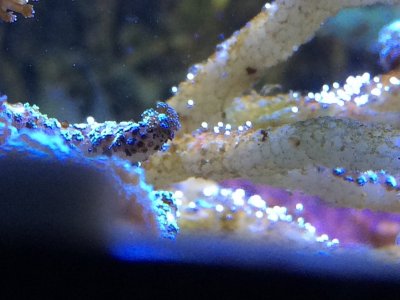- Joined
- May 22, 2016
- Messages
- 6,566
- Reaction score
- 10,146
You have Large Cell Amphidinium, and some Small Cell Amphidinium. The small cell guys go into the water a little bit, and are somewhat affected by UV. You can tell they are better swimmers. Reports of amphidinium toxins seem to come more from the small cell types. So UV may be worthwhile.Bad news! Dino’s are back! They have infested the branch’s of a pocillipora that almost died when my tank went south in January. This coral was almost a foot across but suffered RTN from all the swings in my tank when I was fighting dinos. The plan was to frag off the tips and restart it. Today I noticed the telltale signs off bubbles and some mucus strings. I had amphidinium before but some of these are different. What are they? UV maybe?
Tank is currently NO3 15ppm, PO4 .40 ppm, silicate is at 1 ppm but dosed to increase. The tank is using up silicate at a pretty fast rate with a good population of diatoms.
In the last week the only thing I have added is silicate. Edit, I did run GFO for a few to try and bring PO4 down, it was at .60 ppm but took it back off line day before yesterday. Could that be the cause?
This is turning into a never ending war!
recently dead coral skeleton is prime real estate, in my tank currently it gets thoroughly colonized by diatoms. I imagine all manner of nutrients can be found there.
So to recap from a few different posts, you had elevated P & N, added silica grew some diatoms, then the tank consumption slowed, silica and N & P stayed elevated, dinos halted and basically disappeared, diatom growth slowed.
You added Trace elements and some GFO, now you are growing everything: I think I even saw some moina in that video. That's a first.) your tank nutrient consumption is way up, dinos reappear in force (in susceptible areas). It sounds like you created and then removed a trace element limitation.
If this explanation is correct: under current conditions everything will continue to grow, until whatever limitation or a new one is re-established, and the bloom is halted. In the mean time, since most of your bloom is Large Cell Amphidinium, only manual removal (siphoning) will keep their numbers in check.
If you want to try saving the infested coral and can remove it, I'll send you a PM. I think it could go downhill quickly if any of those dinos are toxic.
Oh, yeah. let me reassure you - you will have plenty of dinos still around after a chemi-clean treatment. lol.Remind me why is vibrant a bad option? Does it not outcompete the Dino’s? What kind of bacteria is it tha is so strong it kills everything? Anybody ever look to see?
Ps my chemicleaned tank has dinos back in less than 24 hours. Might get my control tank back after all.
Anybody know what chemiclean is made of? Erythromycin cetyl chloride. Never mind.
Vibrant being a bacteria source that we know is somewhat harmful to dinos would be a great tool, if it didn't remove all the competitor algae we're trying to establish to replace dinos.
jason2459 has a sick microscope and posted some videos of vibrant on algae - I need to dig them up again - he said it showed in addition to bacteria, something instantly damaging algae cells - though that might just have been osmotic shock of such a concentrated dose under the scope.



















